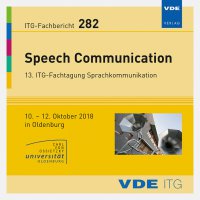RTF-Based Binaural MVDR Beamformer Exploiting an External Microphone in a Diffuse Noise Field
Konferenz: Speech Communication - 13. ITG-Fachtagung Sprachkommunikation
10.10.2018 - 12.10.2018 in Oldenburg, Deutschland
Tagungsband: Speech Communication
Seiten: 5Sprache: EnglischTyp: PDF
Persönliche VDE-Mitglieder erhalten auf diesen Artikel 10% Rabatt
Autoren:
Goessling, Nico; Doclo, Simon (University of Oldenburg, Department of Medical Physics and Acoustics and Cluster of Excellence Hearing4All, Oldenburg, Germany)
Inhalt:
Besides suppressing all undesired sound sources, an important objective of a binaural noise reduction algorithm for hearing devices is the preservation of the binaural cues, aiming at preserving the spatial perception of the acoustic scene. A well-known binaural noise reduction algorithm is the binaural minimum variance distortionless response beamformer, which can be steered using the relative transfer function (RTF) vector of the desired source, relating the acoustic transfer functions between the desired source and all microphones to a reference microphone. In this paper, we propose a computationally efficient method to estimate theRTF vector in a diffuse noise field, requiring an additional microphone that is spatially separated from the head-mounted microphones. Assuming that the spatial coherence between the noise components in the head-mounted microphone signals and the additional microphone signal is zero, we show that an unbiased estimate of the RTF vector can be obtained. Based on real-world recordings, experimental results for several reverberation times show that the proposed RTF estimator outperforms the widely usedRTF estimator based on covariance whitening and a simple biased RTF estimator in terms of noise reduction and binaural cue preservation performance.


